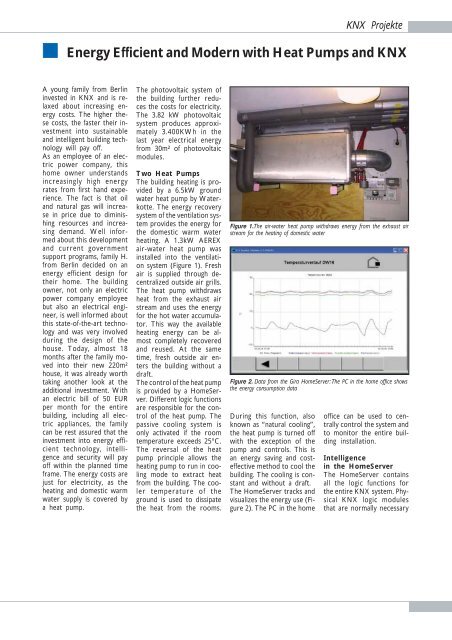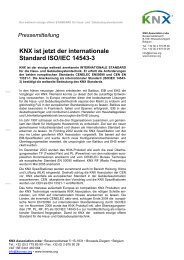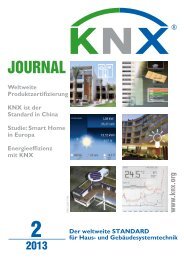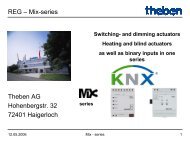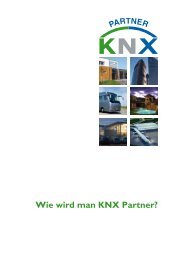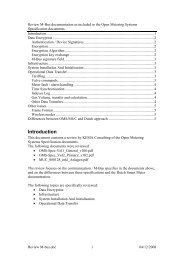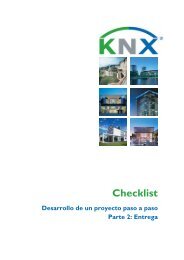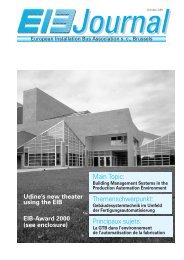English (pdf) - KNX
English (pdf) - KNX
English (pdf) - KNX
You also want an ePaper? Increase the reach of your titles
YUMPU automatically turns print PDFs into web optimized ePapers that Google loves.
<strong>KNX</strong> Projekte<br />
Energy Efficient and Modern with Heat Pumps and <strong>KNX</strong><br />
A young family from Berlin<br />
invested in <strong>KNX</strong> and is relaxed<br />
about increasing energy<br />
costs. The higher these<br />
costs, the faster their investment<br />
into sustainable<br />
and intelligent building technology<br />
will pay off.<br />
As an employee of an electric<br />
power company, this<br />
home owner understands<br />
increasingly high energy<br />
rates from first hand experience.<br />
The fact is that oil<br />
and natural gas will increase<br />
in price due to diminishing<br />
resources and increasing<br />
demand. Well informed<br />
about this development<br />
and current government<br />
support programs, family H.<br />
from Berlin decided on an<br />
energy efficient design for<br />
their home. The building<br />
owner, not only an electric<br />
power company employee<br />
but also an electrical engineer,<br />
is well informed about<br />
this state-of-the-art technology<br />
and was very involved<br />
during the design of the<br />
house. Today, almost 18<br />
months after the family moved<br />
into their new 220m²<br />
house, it was already worth<br />
taking another look at the<br />
additional investment. With<br />
an electric bill of 50 EUR<br />
per month for the entire<br />
building, including all electric<br />
appliances, the family<br />
can be rest assured that the<br />
investment into energy efficient<br />
technology, intelligence<br />
and security will pay<br />
off within the planned time<br />
frame. The energy costs are<br />
just for electricity, as the<br />
heating and domestic warm<br />
water supply is covered by<br />
a heat pump.<br />
The photovoltaic system of<br />
the building further reduces<br />
the costs for electricity.<br />
The 3.82 kW photovoltaic<br />
system produces approximately<br />
3.400KWh in the<br />
last year electrical energy<br />
from 30m² of photovoltaic<br />
modules.<br />
Two Heat Pumps<br />
The building heating is provided<br />
by a 6.5kW ground<br />
water heat pump by Waterkotte.<br />
The energy recovery<br />
system of the ventilation system<br />
provides the energy for<br />
the domestic warm water<br />
heating. A 1.3kW AEREX<br />
air-water heat pump was<br />
installed into the ventilation<br />
system (Figure 1). Fresh<br />
air is supplied through decentralized<br />
outside air grills.<br />
The heat pump withdraws<br />
heat from the exhaust air<br />
stream and uses the energy<br />
for the hot water accumulator.<br />
This way the available<br />
heating energy can be almost<br />
completely recovered<br />
and reused. At the same<br />
time, fresh outside air enters<br />
the building without a<br />
draft.<br />
The control of the heat pump<br />
is provided by a HomeServer.<br />
Different logic functions<br />
are responsible for the control<br />
of the heat pump. The<br />
passive cooling system is<br />
only activated if the room<br />
temperature exceeds 25°C.<br />
The reversal of the heat<br />
pump principle allows the<br />
heating pump to run in cooling<br />
mode to extract heat<br />
from the building. The cooler<br />
temperature of the<br />
ground is used to dissipate<br />
the heat from the rooms.<br />
Figure 1.The air-water heat pump withdraws energy from the exhaust air<br />
stream for the heating of domestic water<br />
Figure 2. Data from the Gira HomeServer: The PC in the home office shows<br />
the energy consumption data<br />
During this function, also<br />
known as “natural cooling”,<br />
the heat pump is turned off<br />
with the exception of the<br />
pump and controls. This is<br />
an energy saving and costeffective<br />
method to cool the<br />
building. The cooling is constant<br />
and without a draft.<br />
The HomeServer tracks and<br />
visualizes the energy use (Figure<br />
2). The PC in the home<br />
office can be used to centrally<br />
control the system and<br />
to monitor the entire building<br />
installation.<br />
Intelligence<br />
in the HomeServer<br />
The HomeServer contains<br />
all the logic functions for<br />
the entire <strong>KNX</strong> system. Physical<br />
<strong>KNX</strong> logic modules<br />
that are normally necessary
<strong>KNX</strong> Projekte<br />
Figure 4. The Info-Display 2.0 show<br />
status messages<br />
Figure 3. Motion detectors function<br />
as sensor for the lighting control and<br />
the alarm system.<br />
were not required. The sun<br />
shading system is tracked<br />
after the sun (time program)<br />
and lighting controlled (light<br />
sensors). Additional functions<br />
of the <strong>KNX</strong> system are<br />
lighting control through<br />
switches, occupancy sensors,<br />
motion detectors, the<br />
alarm system, and switching<br />
of power outlets.<br />
The alarm system uses (aside<br />
from window and door<br />
switches) the same motion<br />
detectors that are used for<br />
the lighting control system<br />
(Figure 3). An info display<br />
next to the main entrance<br />
shows status messages of<br />
the building and the building<br />
system.<br />
It shows date, time, alarm<br />
messages, measurement values<br />
and the status of devices<br />
that are connected to<br />
the <strong>KNX</strong> system.<br />
The info display also serves<br />
as control center: at the<br />
push of a button the light<br />
can be dimmed or switched.<br />
Before someone leaves the<br />
house, the info display can<br />
be checked to see if windows<br />
or doors are still open<br />
(Figure 4).<br />
The connection of an IP<br />
camera to the HomeServer<br />
also allows remote visual<br />
information about the building<br />
condition via a web<br />
browser.


